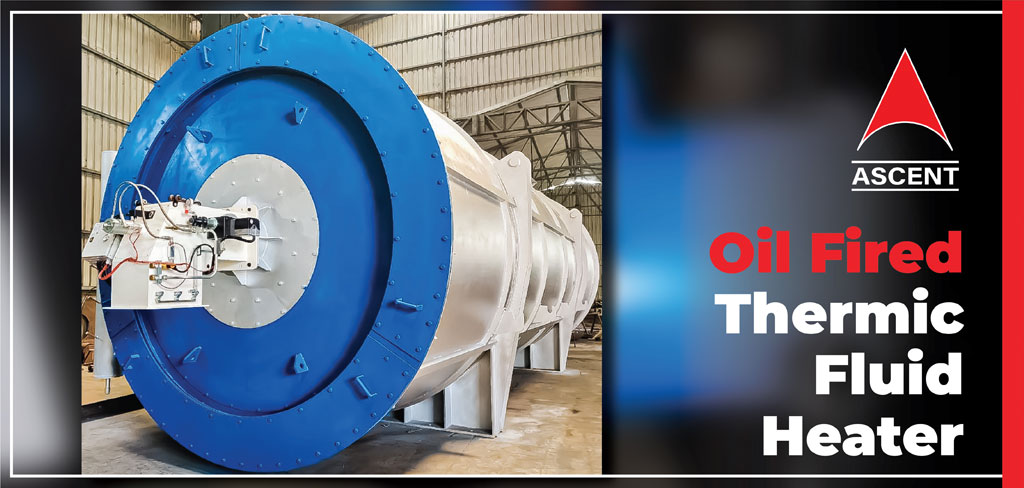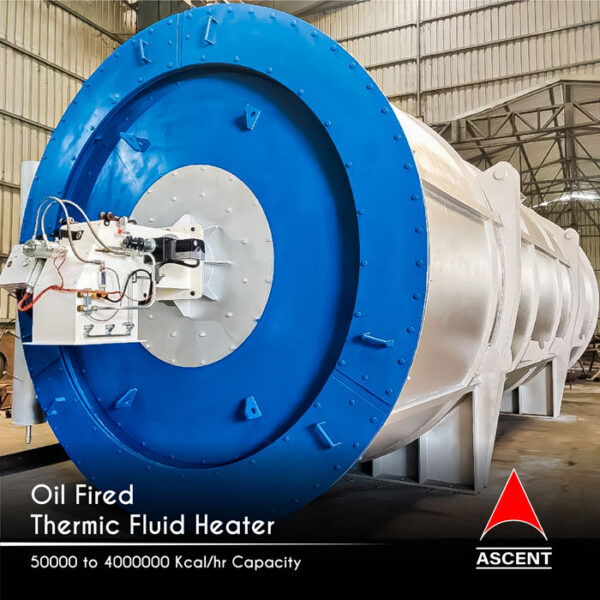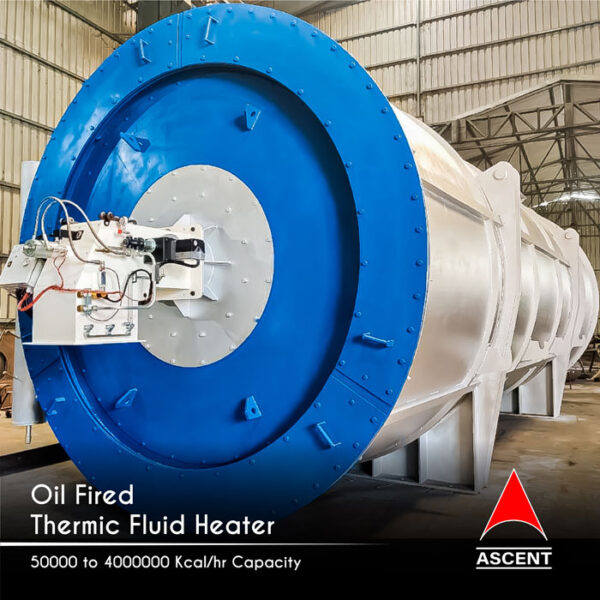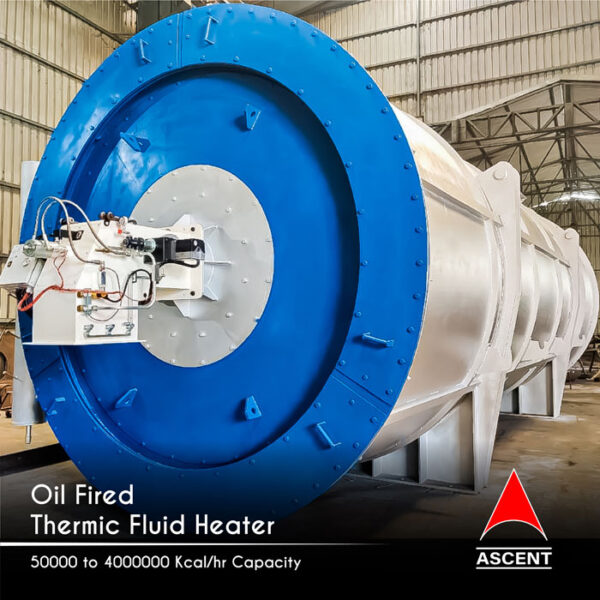Oil Fired Thermic Fluid Heater
Table of Contents
Share
Quick Enquiry Form

Description of Oil Fired Thermic Fluid Heater
An oil fired thermic fluid heater is a type of industrial heater that uses oil as a heat transfer medium to provide heat to a process. It consists of a combustion chamber, a heat exchanger or coil, a circulating pump, and a control panel. The oil is heated in the combustion chamber, which then transfers the heat to the heat exchanger or coil. The hot oil is then circulated through the process to provide the necessary heat. Oil fired thermic heaters are commonly used in industries such as chemical, textile, food processing, and pharmaceuticals, among others. Oil fired fluid heaters offer advantages such as high efficiency, low maintenance, and safety features, making them a preferred choice for heating applications in various industries.
Oil Fired Heater Working Principle
- The Radiation and convective helical coil absorb max heat from the hot flue gases in the radiation zone and twice in the convection zone in cross-flow pattern. The residual heat in the flue gases is selected by the incoming combustion air to ensure optimal heat utilization.
- The 3-pass Firetech Supratherm heater with essential air heater achieves a super efficiency of 88 %.
- The cylindrical combustion chamber has been designed and dimensioned to facilitate optimal combustion, serving as the first pass.
- Flue gases ascend through the second pass, which is formed by the space between two cylindrical tube sections, before descending through the third pass between the outer cylindrical tube section and the gas-tight smoke box casing. Other notable features of the design include symmetrical load distribution, absence of local overheating, and a self-cleaning effect facilitated by the favourable flue gas velocity.
- The heater’s radiation and heating surfaces comprise a tube coil consisting of two concentric cylindrical sections that have been spirally wound to form the combustion and convection heater. This tube arrangement guarantees optimal heat transfer, low fluid pressure loss, low heating surface load, low pump drive motor, stress-free mounting of heating surfaces, and minimal heat loss bridges.
Specifications
| ASCENT Thermic fluid Heater oil Fired | ||||||
| Model | ST – 05 | ST – 10 | ST – 20 | ST – 40 | ST – 60 | ST – 100 |
| Heat Output-kcal/h | 50,000 | 1,00,000 | 2,00,000 | 4,00,000 | 6,00,000 | 10,00,000 |
| Max. Temp. −°C | 300°C | 300°C | 300°C | 300°C | 300°C | 300°C |
| ∆ T°C | 40°C | 40°C | 40°C | 40°C | 40°C | 40°C |
| Flow – m3/h | 3·0 | 5·0 | 10·0 | 20·0 | 30·0 | 50·0 |
| Head – mІc | 50 – 55 | 50 – 55 | 50 – 55 | 50 – 55 | 50 – 55 | 50 – 55 |
| Thermal Efficiency % | 88±2% | 88±2% | 88±2% | 88±2% | 88±2% | 88±2% |
| Fuel (Light Oil) kg/h | 6 | 11 | 22 | 44 | 67 | 111 |
| Fuel (heavy Oil) kg/h | N/A | N/A | 24 | 47 | 71 | 118 |
| Connected Load – Kw | ||||||
| Light Oil | 3 | 4.5 | 5 | 8 | 10 | 16 |
| Heavy Oil | N/A | N/A | 8 | 11 | 16 | 25 |
| Thermic Fluid Content in the Coils – litres | 20 | 30 | 60 | 215 | 330 | 615 |
| Expansion Tank capacity (Litres) | 100 | 200 | 200 | 500 | 500 | 1000 |
| Inlet/Outlet Size – mm | 25 | 40 | 50 | 65 | 80 | 100 |
| Dry weight of Heater – kg | ||||||
| Light Oil | 750 | 925 | 1050 | 2300 | 2750 | 4100 |
| Heavy Oil | N/A | N/A | 1150 | 2400 | 2850 | 4200 |
| Overall Dimensions – mm | ||||||
| Height | 1600 | 2100 | 2300 | 2800 | 3300 | 3800 |
| Length | 1200 | 1500 | 1600 | 1900 | 2200 | 2500 |
| Width | 700 | 850 | 1100 | 1900 | 1950 | 2200 |
NOTE:
|
||||||
Advantages of Oil Fired Thermic Fluid Heater
- Construction: – Designed on forced circulation principle Heat Exchange fabricated out of high temperature resistant seamless tubes, once through the spiral coil nest is arranged to give 3 clear passes of flue gases forming a combustion zone. It ensures an optimal rate of heat release and maximum heat transfer and low stack temperature.
- Safety & Controls: – Supratherm system provides several safety interlocks, indicators and alarms for a safe and reliable operation.
- Long Life: – A thermal fluid system can operate between 100°C and 350°C without any pressure increase. The Supratherm system needs mineral oil as heat transfer media, which is non- corrosive and free from any external particles. This ensures low maintenance cost and higher reliability.
- Operation without pressure: – The Supratherm low pressure system is designed to operate without the need for high pressure equipment, functioning efficiently between 100°C and 350°C. This results in a safer, more cost-effective system with high efficiency.
- Fully automatic safe operation and instant information: – The heater’s operation is fully automated, with a single switch controlling the burner’s IN and OUT functions to meet process heat loads. The system requires minimal attention during normal operation, with an easily accessible control and instrument panel providing instant information on heat generation.
- Ultra-modern, sleek & elegant design: – The heater and accessories are mounted on a common skid with an attractive front instrument and control panel, boasting an ultra-modern, sleek, and elegant design. The pre-assembled and pre-wired unit reduces on-site erection time and allows for close proximity to the process.
- Non-corrosive System: – The Supratherm system utilizes a non-corrosive mineral oil as its heat transfer medium, resulting in low maintenance costs and higher reliability due to the absence of foreign particles.
- No explosion Risks: – With low thermal inertia and a fully automatic safety trip system, the Supratherm system poses no risk of explosion and ensures fully safe operation.
- No Boiler regulation: – The Supratherm heater falls outside the purview of Indian boiler regulations, eliminating the need for annual shutdown and providing further cost savings.
List of Components
- CONSTRUCTION: Ultimately placed in a double shell mounted on a robust steel frame for quick and easy installation.
- BURNER, BLOWER & OIL PUMP ASSEMBLY:
- Centrifugal Blower coupled with motor
- Vertically downward position placed monobloc burner complete with nozzle, nozzle holder, diffuser plate, ignition electrodes, photocell, sight glass & solenoid valve.
- Gear oil pump coupled with motor
- Oil filter and pressure gauge.
- THERMIC FLUID CIRCULATING PUMP: TFH circulating pump appropriate to handle high temp. thermic fluid directly coupled to an Electric Motor.
- DEAERATOR-CUM-EXPANSION TANK: Accurately designed tank effectively removes any liberated gas, prevents oxidation and pump cavitation. It also accommodates expansion of thermic fluid. It is finalized with level switch, gauge glass assembly, blow down valve, overflow nozzle, inlet and outlet nozzles, Top up nozzle.
- MOUNTINGS, FITTINGS, INSTRUMENTS AND SAFETIES:
| Pressure indicator with isolating valve to measure pressure in
Inlet line of T.F.H. Outlet line of T.F.H. |
1 No.1 No. |
| Fuel oil line | 1 No. |
| Digital temperature indicator cum controller at inlet line of TFH to measure and control burner ON/OFF condition. | 1 No. |
| Digital temperature indicator cum controller to measure outlet temperature. | 1 No. |
| Photocell mounted on Burner to sense flame and trip burner in case of No flame with alarm. | 1 No. |
| Differential pressure switch for protection in case of No-flow/low flow conditions connected between inlet/outlet TFH line | 1 No. |
| Solenoid valve at the fuel inlet of Burner | 1 No. |
| Hooter, flasher and Neon bulbs for abnormal working conditions | 1 No. |
| Low level switch in Deaerator-cum-Expansion tank for protection against low level of Thermic fluid resulting into burner trip | 1 No. |
| Sequence controller to operate the system automatically and stop in case of abnormal conditions. | 1 No. |
- CONTROL PANEL: Dust proof control panel mounted in the front side of TFH at convenient height is pre-wired and complete with starters, push buttons, indicating lamps, all duly labelled fuses, O/L relays contactors, sequence controller.
- Safety and controls: The Supratherm system comes equipped with various safety interlocks and indicators to ensure safe operation. These features include:
-
- Audio visual alarm and burner trip for outlet temperature that is too high.
- Visual alarm and burner trip for inlet temperature that is too high.
- Audio visual alarm and burner trip for low expansion tank level.
- Audio visual alarm and burner trip for low fuel temperature.
- Audio visual alarm and burner trip for flame failure.
- Spring-loaded safety valve for high fluid pressure.
- Burner programmer in auto firing that monitors flame suppression.
- Audio visual alarm and burner trip for low fuel pressure.
- Audio visual alarm and burner trip for low fluid flow.
Application of Oil Fired Thermic Fluid Heater
Oil-fired thermic fluid heaters find application in various industries where heat transfer fluid is required to be heated to a specific temperature for various industrial processes. Some of the industries where oil-fired thermic fluid heaters are used are:
- Chemical Industry: In the chemical industry, oil fired thermic heaters are used for heating reactors and vessels to perform various chemical reactions. The precise temperature control offered by these heaters helps in achieving the desired reaction rates and improving product quality.
- Textile Industry: The textile industry uses oil thermic fluid heaters for dyeing and printing of fabrics. The heaters provide precise temperature control, which is critical for obtaining consistent colour and quality in the textile products.
- Food Processing Industry: In the food processing industry, oil fluid heaters are used for heating ovens, boilers, and other equipment to cook, bake, or roast food products. The heaters provide fast and efficient heating, resulting in increased productivity and reduced energy costs.
- Pharmaceutical Industry: Thermic fluid heaters find application in the pharmaceutical industry for manufacturing drugs and medicines. The heaters provide precise temperature control, which is essential for maintaining the quality and efficacy of the drugs.
- Plastic and Rubber Industry: The plastic and rubber industry uses oil fired heaters for molding and curing of plastic and rubber products. The heaters offer fast and efficient heating, resulting in increased productivity and reduced energy costs.
- Paper Industry: The paper industry uses fluid heaters for drying paper during the paper manufacturing process. The heaters provide precise temperature control, which is critical for obtaining consistent paper quality.








